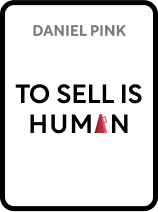

This article is an excerpt from the Shortform book guide to "To Sell Is Human" by Daniel H. Pink. Shortform has the world's best summaries and analyses of books you should be reading.
Like this article? Sign up for a free trial here .
What are the three core components of modern sales? Why should you upserve rather than upsell?
According to Daniel Pink in To Sell Is Human, the three components of modern sales are the pitch, the ability to improvise, and serving others. In addition, Pink says that you must always be in the mindset of “What can I do for others?” rather than “What can others do for me?”.
Continue on for Daniel Pink’s modern sales tips.
Modern Sales Actionables
We can put the modern sales ABCs of sales into action by using 3 core components.
Component #1: Pitch
To pitch is to move others with your ideas. It’s inspired by the original “pitch,” known as The Elevator Pitch. Now outdated, there are six evolved alternatives to the elevator pitch. Each pitch uses at least one of the components of the modern ABCs.
Pitch #1: The One-Word Pitch
Simplify each of your ideas down to one word. This boosts clarity and improves discipline.
For example, one of the one-word pitches Barack Obama’s campaign ran on was “hope.”
Pitch #2: The Question Pitch
Consider your idea, and formulate that idea into a question that functions as a statement. Questions invite connection, contemplation, and collaboration, which creates movement.
For example, if the idea you’re selling is, “You need a new car,” your question might be, “Is your car running the same as it did when you first bought it?”
Pitch #3: The Rhyming Pitch
Determine the key part of your idea, and turn that into a rhyme (question or statement). Research indicates that rhymes encourage reasoning, which improves clarity.
For example, “An apple a day keeps the doctor away.”
Pitch #4: The Subject-Line Pitch
When emailing a pitch, use the subject line to create one that is practical, specific, and invites interest.
For example, “3 Reasons Why You Are Never Satisfied.”
Pitch #5: The Twitter Pitch
Practice using the character count on Twitter posts to create an actionable, engaging Twitter pitch. This can be a great question, something self-promotional, or informative.
For example: “Sick of your old car? Ready to make your dreams come true with a new one? Click this link for a fantastic deal: ________”
Pitch #6: The Pixar Pitch
This is the go-to pitch style in Hollywood. It’s quick and persuasive, and it uses storytelling to influence collaboration, which supports attunement.
The pitch structure is, “Once upon a time…..one day…..because of that…..because of that….until finally.”
For example, “Once upon a time there was a girl whose lifelong dream was to drive to every state in America and visit its capital. Unfortunately she had no car. Because of that, she went to the best car dealership in her small town. Because of that, she met a kind salesman who tirelessly worked to find her the perfect car for her cross-country adventure, until finally, she owned her very first car and there was nothing standing in the way of her achieving her dream.”
Component #2: Improvise
Improvisation is a critical part of successful sales. It is especially useful when everything you’ve carefully planned fails to move people as intended. The core benefit from a sales perspective is that it allows you to develop openness and flexibility. These qualities support attunement (the A in the modern ABCs).
There are three rules for successful improvisation.
Rule #1: Listen
Often, we are not truly listening to each other. We are listening passively, a transactional process, instead of actively, a transformative process. This rule encourages active listening, which improves clarity in a sales transaction.
Three tips for active listening:
Tip #1: Slow down
Tip #2: Be present
Tip #3: Listen to listen, rather than to respond.
For example, say you’re in the middle of a transaction with a buyer. She is talking about her previous experience with salespeople. If you’re listening passively, you might tune out and think about how you’re going to get her to make a purchase. If you’re listening actively, you are present, listening closely, and allowing the information you learn to improve clarity so you can better serve her needs.
Rule #2: Say Yes
Avoid using language that shuts a conversation down or deflects. Always say something along the lines of, “Yes, and.” In a modern sales context, collaborative openness expands existing possibilities and creates new ones, boosting both attunement and clarity.
For example, imagine you’re an Apple store employee, and a customer wants to buy an iPad. They ask you if insurance comes with it. Insurance is a separate purchase, but rather than saying, “No, you have to buy it separately,” you can say, “Yes, and it costs _____.” The second phrasing keeps the flow of the transaction moving, instead of halting it with a no.
Rule #3: Use Principled Negotiation
Always navigate transactions with a “win/win” intention. Rather than favoring one person, create possibilities that will benefit all involved.
For example, let’s say you’re selling a service, and you’re about to close the sale with an upsell. You realize that the buyer wouldn’t benefit from the additional service. With a win/win mindset, you’re honest with the buyer about the value of it. The buyer walks away having only purchased the original service, but the final transaction favors both parties.
Component #3: Serve
Modern sales is about being of service to others. This means you should be selling with the intention of improving someone else’s life.
There are two underlying steps to service-oriented sales.
Step #1: Make It Personal
Often, we are too impersonal in sales environments. We’d rather be “professional.” This keeps us too distanced to attune to potential buyers. Make what you’re selling personal to you. This communicates that your intention is to be of service, and you’re not just seeking your own gain. Personalizing improves performance and boosts the quality of the service.
For example, say you’re selling cell phones, but you’re not really passionate about it, so you see potential buyers as a means to an end (profit). In contrast, if you really love selling phones, you’re going to see potential buyers as people you can help. This will automatically improve your service.
Step #2: Make It Purposeful
Take it one step further, and try connecting what you’re selling to a broader purpose. Studies show the desire to serve is innate. You are most successful when you believe you are serving not just yourself, or the buyer, but a deeper purpose. Always be thinking about how your service can improve the world as a whole, and do your best to frame it that way to potential buyers.
For example, if you’re a teacher, remind yourself that you are not just getting a paycheck, or improving the lives of the people you’re educating, you are preparing those people to take what they learn and improve the world.
Bonus Step: Don’t Upsell, Upserve
When you upsell, you are generally serving your own best interest. You are in a mindset of, “What can others do for me?” When you upserve, you are supporting buyers to meet needs they didn’t know they had. This is a mindset of, “What can I do for others?”
For example, say you’re selling a phone. Your buyer is elderly and needs something simple. If you upsell, you might try to sell her a high tech, expensive phone with lots of features, because it will get you a commission. If you upserve, you will support the buyer to find the most reliable, easy-to-use product, even if it means a lower commission.

———End of Preview———
Like what you just read? Read the rest of the world's best book summary and analysis of Daniel H. Pink's "To Sell Is Human" at Shortform .
Here's what you'll find in our full To Sell Is Human summary :
- Why we are all salespeople in the modern world
- The history, evolution, and significance of sales
- How you can effectively harness sales skills to create purpose, growth, or “movement” in your life






